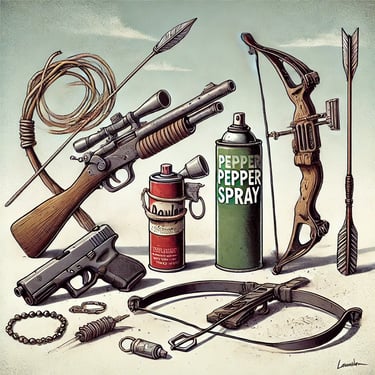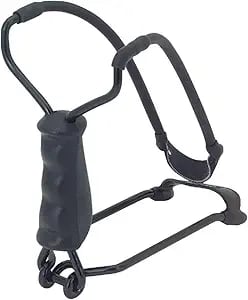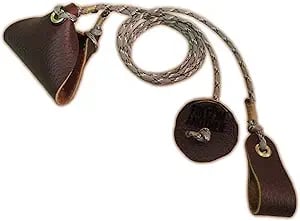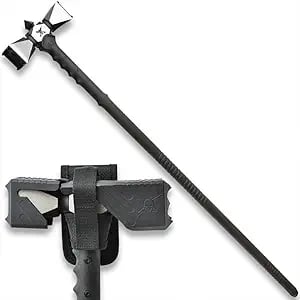Apocalypse Weapons to Avoid: Practical Choices for Survival
Learn which apocalypse weapons to avoid, including guns and crossbows that require ammo or maintenance. Discover timeless, reliable tools for true survival.
SURVIVALSATIRE
As an Amazon Associate, I earn from qualifying purchases. This means I may earn a commission if you click on an affiliate link and make a purchase, at no extra cost to you.




Daisy B52 Slingshot


Shepherd Sling/Sling Shot/Rock Sling: Desert Camo


M48 Double-Headed War Hammer XL And Sheath - 2Cr13 Stainless Steel Head, Penetrating Points, Black Oxide Coating, Injection-Molded Handle - Excellent for Smashing and Breaching - Length 38 1/2”
Weapons to Avoid
In the apocalypse, efficiency and availability are key. Weapons that rely on limited or costly supplies can quickly become more of a burden than a benefit.
Guns: Despite their popularity, guns require a constant supply of ammunition, which will be scarce in a collapsed society. Additionally, firearms require regular maintenance, can jam, and make loud noises, drawing unwanted attention.
Bows and Arrows: While the bow has its place in history as a hunter’s weapon, it requires a supply of arrows that can be hard to replace or make. Arrows can break, get lost, or dull over time, and crafting new ones requires specialized materials and skills.
Crossbows: Crossbows have power and range but suffer from the same limitations as traditional bows. They require bolts, which are heavy and difficult to replace. Reloading a crossbow is also time-consuming and not ideal for high-stress or rapid-response situations.
Pepper Spray and Tear Gas: While effective for self-defense, these items are single-use and difficult to restock. Additionally, wind direction can render them ineffective or even backfire, creating a hazardous situation for the user.
Explosives and Fireworks: Although they may seem like a good idea for large threats, explosives are risky, noisy, and dangerous. They require knowledge to use safely, and materials to make them are highly regulated, so restocking is nearly impossible.
Throwing Knives: These require significant skill and are often ineffective unless perfectly aimed. They can also be lost or damaged on impact, leaving you defenseless and without a vital tool.
Instead, focus on weapons that don’t need regular restocking or expert maintenance. Below are timeless tools that have stood the test of centuries, keeping people safe with simple effectiveness.
1. The Sling: David’s Legendary Weapon of Faith
History:
The sling has been used for thousands of years as both a hunting tool and a weapon in battle. Ancient armies, including those of the Israelites, often employed skilled slingers who could strike with deadly accuracy. David’s famous encounter with Goliath in 1 Samuel 17:49 showed that, with God’s help, even a simple sling could bring down giants.
Pros:
Lightweight and portable: Easy to carry and doesn’t take up much space.
No cost for ammunition: Rocks and small stones are plentiful in nature.
Silent: Useful for stealth in hunting and survival situations.
Cons:
Requires practice: Precision takes time and dedication.
Limited range: Effective within a certain distance only.
Less effective against multiple attackers: Best suited for one-on-one encounters.
Suggested Sling: Handcrafted Leather or Paracord Sling
Crafting a sling from leather or paracord is affordable and easy. With practice, it becomes a tool that can provide both protection and sustenance, echoing the resourcefulness and faith of David.
2. The Staff: God’s Tool for Guidance and Defense
History:
The staff has a symbolic presence in the Bible, representing guidance, authority, and protection. Moses used his staff to perform miracles, such as parting the Red Sea (Exodus 14:16), while shepherds relied on it for protection. In survival, the staff offers a dignified yet practical option for both support and defense.
Pros:
Multipurpose: Serves as both a walking aid and a defensive tool.
Accessible and affordable: Sturdy sticks are readily available.
Intimidating appearance: Even without striking, it can deter potential threats.
Cons:
Limited offense: Primarily defensive in nature.
Less effective against armor: Cannot penetrate armor or other strong defenses.
Requires strength and coordination: Mastering its use takes practice.
Suggested Staff: Hickory or Oak Walking Staff
A sturdy staff, ideally crafted from hickory or oak, is useful for protection and support on any journey. In the face of trials, it’s a reliable reminder of how God uses the simplest tools to accomplish His will.
3. The Machete: Survival’s Unsung Hero
History:
Originating as a farming and forestry tool, the machete has long been used in tropical regions for clearing brush, harvesting crops, and, yes, as a weapon. While not specifically mentioned in the Bible, it represents practical wisdom, echoing Proverbs 6:6, where we are called to learn from the ant’s resourcefulness.
Pros:
Versatile: Effective for chopping wood, cutting paths, and protection.
Intimidating appearance: Its size alone can serve as a deterrent.
Affordable: Available in most stores and lasts for years with proper care.
Cons:
Heavy to carry: Can be cumbersome on long journeys.
Close-range: Requires proximity to be effective.
Needs sharpening: Frequent use dulls the blade over time.
Suggested Machete: High-Carbon Steel Blade
A high-carbon steel machete offers durability and a sharp edge for tough situations. It’s an essential tool for any apocalyptic survivor, useful for everything from shelter-building to self-defense.
4. The Spear: The Ancient Warrior’s Weapon
History:
One of the oldest weapons known to humankind, the spear has served in hunting, fishing, and battle since prehistoric times. The Bible references spears in several places, such as when Joshua led Israel into battle (Joshua 8:18), highlighting its role in both combat and survival.
Pros:
Long reach: Allows for distance between you and your target.
Simple to make: Requires only a sharpened end and a sturdy pole.
Multipurpose: Useful for hunting as well as self-defense.
Cons:
Bulky: Can be difficult to carry or wield in confined spaces.
Requires practice: Skill is needed for effective use.
Limited versatility: Less useful for tasks other than defense or hunting.
Suggested Spear: Wooden Staff with Knife or Metal Tip
Secure a knife to a long wooden pole with duct tape or paracord, creating a makeshift spear. This weapon offers reach and practicality, perfect for hunting or repelling any unwanted advances.
5. The Hammer: Noah’s Faithful Tool of Construction
History:
The hammer might not seem like a weapon at first glance, but it’s been invaluable in biblical times. Noah likely used simple tools to build the ark (Genesis 6:14-16), constructing a safe haven for his family. As a survival weapon, the hammer doubles as both a construction tool and a last-resort defense.
Pros:
Multipurpose: Great for both building and self-defense.
Durable: Can withstand heavy use over time.
Inexpensive: Widely available and affordable.
Cons:
Limited reach: Requires close contact to be effective.
Heavy to carry: Can add significant weight to your pack.
Requires strength: Effectiveness depends on the user’s strength.
Suggested Hammer: 16-Ounce Steel-Headed Hammer
A steel-headed hammer is practical for building, shelter repair, and self-defense. Lightweight yet powerful, it reminds us that faith in God and resourcefulness go hand in hand.
6. The Crowbar: The Relentless Tool of Resilience
History:
Though not a weapon of biblical lore, the crowbar has been a staple for survivalists and explorers for its sheer versatility. In an apocalyptic world, it serves not only as a weapon but as a tool for opening doors, clearing debris, and prying open anything in your way.
Pros:
Highly versatile: Functions as both a weapon and a tool.
Low maintenance: No sharpening or special care required.
Durable and reliable: Built to last in tough conditions.
Cons:
Limited reach: Best used at close range.
Heavy and awkward: Difficult to carry for extended periods.
Blunt force only: Not effective for cutting or other precise tasks.
Suggested Crowbar: 24-Inch Forged Steel
A crowbar is ideal for both defense and practical survival tasks. This tool’s strength and reliability make it a must-have for navigating the chaos of the end times.
If you liked this, you’ll love exploring more on survival, preparedness, and a bit of snark over at Warhammer Blades:
